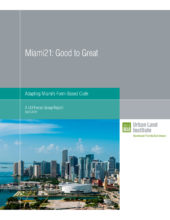Brought together by the Urban Land Institute, Miami’s real estate leaders provide recommendations to update and improve the Miami21 zoning code.

In 2018, local industry leaders serving on the ULI Southeast Florida / Caribbean’s Advisory Board recommended an evaluation of Miami 21 zoning code to assist and inform efforts currently underway by the city to revisit and revamp the code.
In response, the district council invited contributers with vast experience working with Miami 21 to join a focus group to determine priority fixes for the code. The group’s evaluation of the code focused on its ability to address key priority areas in the region: housing choice, housing affordability, and mobility.
TOPICS:
Miami21
Miami zoning code
Recommendations
Updates
Housing affordability
Infill development
Mobility
Transit-Oriented Development
Recommendations Overview
1. Remove barriers in the code that prevent the development of small-scale, infill, and Missing Middle housing:
- Lot size minimums in T4, T5, and T6
- Floorplate area maximums that include balconies
- Density maximums in T4 and T5
- Parking minimums in T4, T5, and T6
2. Update parking, loading, and on-street usage requirements to match new mobility, delivery, and service methods and usage patterns.
3. Enable Transit-Oriented Development along new and potential transit corridors by extending TOD zoning benefits such as increased density and decreased parking requirements to Transit Corridors.
About Miami 21
Over 10 years ago, the City of Miami approved Miami 21, the first New Urbanist Smart Code to be applied to a large existing city in the United States. The purpose of the new zoning code was to direct the city toward transit-oriented, pedestrian-friendly growth, and away from disjointed, car-centered development. The new code established a holistic, logical, comprehensive, and practical framework for the city guided by the tenets of Smart Growth, setting walkable urbanism as the default pattern citywide and improving cohesion, connectivity, appearance, and the pedestrian experience.
Read more more about Miami’s zoning code:
